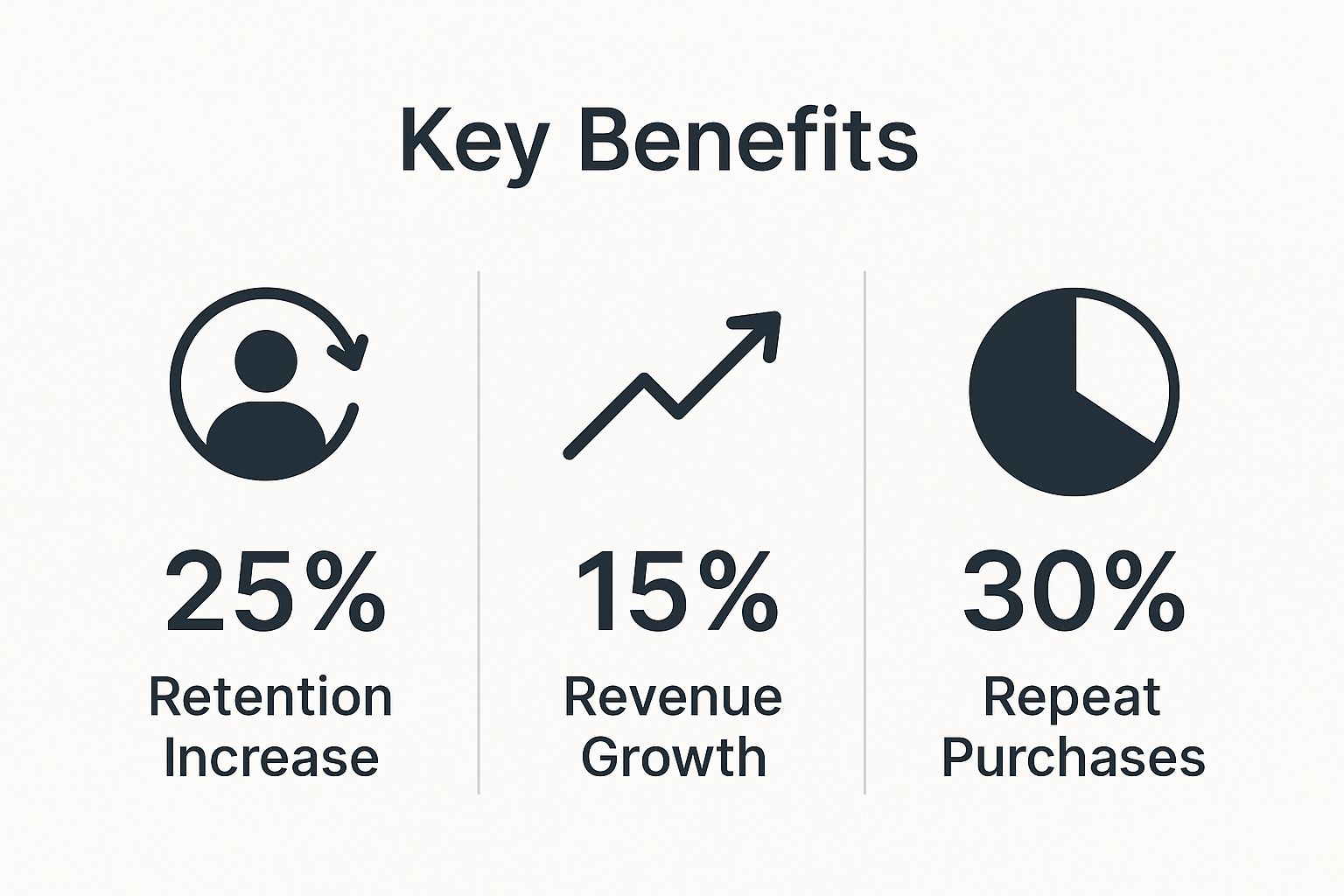Mastering Client Satisfaction Metrics for Growth
Unlock business growth by mastering client satisfaction metrics. Learn how to measure, analyze, and improve NPS, CSAT, and CES for real-world results.

Client satisfaction metrics are the tools you use to measure how happy your clients really are with your products, services, and the whole experience of working with you. Think of them as the dashboard in your car—they give you the hard data you need to steer your business, speed up growth, and dodge hazards like client churn. In short, they turn vague feelings into concrete numbers you can actually work with.
Why Client Satisfaction Metrics Matter
Measuring client satisfaction is the difference between guessing what your clients want and knowing what they need. If you're not tracking these metrics, you're flying blind. You're making big decisions based on gut feelings instead of solid evidence, leaving you wide open to competitors who are paying close attention to what their customers are saying.
It’s like a restaurant owner who never asks diners how their meal was. They might see clean plates and assume everyone loved it, but they're missing the quiet dissatisfaction of customers who are never coming back. Client satisfaction metrics are your way of "checking in with the table" on a massive scale, gathering the feedback you need to perfect your service and build real loyalty.
The Foundation of Sustainable Growth
When you consistently track these numbers, you get a direct line into your client's world, helping you see their entire journey with your company. This insight is crucial for a few key reasons:
- It Pinpoints Friction: Metrics like the Customer Effort Score (CES) show you exactly where your processes are making things difficult for clients. This lets you smooth out those rough patches before they become deal-breakers.
- It Drives Loyalty and Retention: Happy clients stick around. It’s that simple. In fact, research shows that 73% of customers will jump ship to a competitor after just a few bad experiences, which makes keeping satisfaction high an urgent priority.
- It Informs Product Development: This feedback isn't just for your support team. It’s pure gold for your product managers. It tells them which features clients are clamoring for and which bugs are causing the most headaches.
- It Creates Brand Advocates: A metric like the Net Promoter Score (NPS) doesn't just measure happiness—it measures loyalty. A high NPS means you have an army of clients ready to sing your praises to others, doing your marketing for you.
Ultimately, these aren't just vanity numbers to display on a screen. Each metric tells a piece of a much larger story about the relationship you have with your clients. Understanding that story is the first step toward building a business that doesn't just win customers, but keeps them for life. When you move past the basic definitions and learn to read these signals, you turn client feedback from a simple report card into a powerful roadmap for your future.
The 3 Core Metrics Every Business Needs to Track
It's easy to get lost in the sea of client feedback data. But the truth is, you don't need a hundred different metrics. You just need the right ones. Think of them less as interchangeable numbers and more as specialized tools in your toolkit, each built for a specific job.
Understanding what each metric is designed to do is the key to building a feedback program that gives you insights you can actually use, not just a dashboard full of scores. Let's break down the "big three" that every business should have a handle on.
Net Promoter Score (NPS): The Loyalty Compass
Net Promoter Score, or NPS, is all about the big picture. It measures long-term client loyalty with one straightforward question: "On a scale of 0-10, how likely are you to recommend our company to a friend or colleague?" This isn't about a single purchase; it’s a gut check on the client's entire relationship with your brand.
Based on their answer, clients fall into one of three camps:
- Promoters (Score 9-10): These are your champions. They’re the loyal, repeat buyers who actively tell others about you, driving organic growth.
- Passives (Score 7-8): These clients are satisfied enough for now, but they aren't emotionally invested. They're easily swayed by a competitor's shiny new offer.
- Detractors (Score 0-6): These are your unhappy clients. Not only are they at high risk of leaving, but they can also damage your reputation through negative word-of-mouth.
Your final NPS score is simply the percentage of Promoters minus the percentage of Detractors. This single number gives you a powerful, high-level snapshot of your brand's health and its potential for word-of-mouth growth.
Customer Satisfaction Score (CSAT): The Happiness Check
While NPS looks at the long-term relationship, Customer Satisfaction Score (CSAT) is your in-the-moment reality check. It zeroes in on a client's happiness with a specific interaction, like a support call, a recent purchase, or a new feature they just tried.
The typical CSAT question is direct: "How satisfied were you with your recent support experience?" Answers usually fall on a 5-point scale, from "Very Satisfied" to "Very Unsatisfied."
For example, a sudden dip in CSAT scores after a software update is a huge red flag for your product team—it could point to a bug or a confusing design change. On the flip side, a glowing score for a support agent highlights a star performer who deserves recognition.
To dig deeper into how these metrics work together, check out this excellent resource on Mastering Customer Satisfaction Measurement.
The proof is in the numbers. Focusing on these metrics isn't just a "nice-to-have"; it directly impacts your bottom line.

As the data shows, a strategic focus on client satisfaction is a direct driver of retention, revenue, and loyalty.
Customer Effort Score (CES): The Friction Detector
Last but certainly not least is the Customer Effort Score (CES). This metric asks a fundamentally different question: How easy was it for your client to get what they needed? It's based on a simple but powerful idea—people stick with companies that are easy to do business with.
After an interaction, you ask something like, "The company made it easy for me to handle my issue." Clients then agree or disagree on a scale.
A high-effort score is a massive warning sign. If clients have to jump through hoops to resolve a problem, navigate a confusing website, or repeat their issue to three different agents, their loyalty craters. In fact, research shows that 96% of customers who have a high-effort experience become more disloyal, compared to just 9% of those with a low-effort one.
CES is your friction detector. It helps you find and smooth out the bumps in your customer journey, creating an effortless experience that keeps people coming back.
Comparing the Top 3 Client Satisfaction Metrics
Choosing the right metric depends entirely on what you want to learn. Are you measuring the overall brand relationship, a specific touchpoint, or the ease of the experience? This table breaks down the "big three" to help you decide.
| Metric | What It Measures | Typical Question | Best Used For |
|---|---|---|---|
| NPS | Long-term loyalty and brand advocacy | "How likely are you to recommend us to a friend or colleague?" | Gauging overall brand health and predicting future growth. |
| CSAT | Immediate satisfaction with a specific interaction | "How satisfied were you with your recent purchase/support call?" | Getting real-time feedback on specific touchpoints like service or products. |
| CES | The ease of a client's experience or interaction | "The company made it easy for me to handle my issue. (Agree/Disagree)" | Identifying and removing friction or obstacles in the customer journey. |
Ultimately, these metrics aren’t in competition with each other. The most successful companies use a combination of NPS, CSAT, and CES to get a complete, 360-degree view of the client experience.
Why High Satisfaction Scores Can Be Deceiving
Getting a high CSAT score feels great.Your dashboard is green, the team feels good, and it seems like your clients are happy. But then, one of those supposedly "happy" clients leaves without warning. What happened?
Welcome to the "satisfaction trap." It’s a dangerous blind spot for any business that relies too heavily on surface-level metrics.
The hard truth is that satisfaction doesn't always equal loyalty. A client might be perfectly satisfied with a single transaction—a support ticket was closed quickly, or a product showed up on time. But that moment of satisfaction doesn't mean they feel any real connection to your brand. It’s the difference between a pleasant chat with a stranger and a real friendship.
That kind of transactional satisfaction is fragile. It can be shattered by one bad experience or wiped out by a competitor who's just a little bit cheaper or faster. Real, lasting loyalty is built on something much deeper.

Looking Beyond the Score
To get out of the satisfaction trap, you have to look past the numbers and start digging into the emotional drivers that keep clients around. These are the relational ingredients that a basic CSAT survey just wasn't designed to measure.
Think of it this way: a high satisfaction score tells you that you delivered what you promised in a specific interaction. But loyalty answers a completely different set of questions:
- Emotional Connection: Do our clients feel like we actually get them?
- Trust: Do they believe we have their back, even when something goes wrong?
- Consistent Value: Do they feel they consistently get more from us than they would from anyone else?
These are the things that make a client stick with you through a price increase or a minor service hiccup. They’re the foundation of a relationship that can take a hit, and you won’t find them in a simple five-star rating after a support call.
This gap between what people say in a satisfaction survey and how they actually behave is growing. Recent global consumer studies show that while satisfaction levels have mostly leveled off, the metrics that actually matter for loyalty are falling behind. Things like trust, advocacy, and the intent to buy again have shown declines even when satisfaction scores look okay. It suggests that the emotional bond is weakening. You can dig into these trends in the 2025 Global Consumer Study from Qualtrics XM Institute.
Combining Data for a Clearer Picture
The answer isn't to throw out CSAT. The key is to enrich it with other client satisfaction metrics that measure the relationship, not just the transaction. This is where you absolutely have to combine your quantitative data with qualitative feedback to understand what really keeps people coming back.
Here’s a practical way to get a much more accurate view of where you stand:
- Pair CSAT with NPS: Use CSAT for that immediate, post-interaction feedback to check the health of your individual touchpoints. Then, use NPS quarterly or semi-annually to zoom out and measure the overall relationship and predict long-term loyalty.
- Analyze Open-Ended Feedback: The real gold is in the comments. Whether it’s the "why" behind an NPS score or the notes from a support ticket, this qualitative data reveals the emotions and specific pain points your scores can't.
- Hold Direct Conversations: Nothing will ever replace just talking to your clients. Regular check-ins, especially with high-value accounts or recent detractors, give you context that no survey ever could.
When you start weaving these different threads of information together, your focus naturally shifts from chasing a high score to building genuine, lasting relationships. You begin to see your clients not as data points on a chart, but as partners in your growth. That holistic view is the only way to build a customer base that isn't just satisfied, but truly loyal.
Building Your Client Feedback Program From Scratch
Knowing what client satisfaction metrics are is one thing; actually putting them to work is another. It can feel like a huge jump. But here’s the secret: building a great feedback program isn't about launching some massive, complicated system all at once. It's about starting smart with a clear plan you can grow over time.
Think of it like building a house. You don't just throw up some walls and hope for the best. You start by pouring a solid foundation. For a client feedback program, that foundation is a crystal-clear understanding of your client's journey.
Map Your Customer Journey
Before you can measure anything, you need a map. A customer journey map is your blueprint—a visual guide to every single interaction a client has with your company. It starts the moment they first hear about you and continues all the way to them becoming a loyal fan.
This exercise forces you to get out of your own head and walk in your customer’s shoes. You'll trace their path through awareness, consideration, purchase, getting service, and hopefully, long-term loyalty. The whole point is to identify every key touchpoint where their experience is made or broken.
Identify the Moments That Matter
Let’s be honest, not all touchpoints are created equal. Some are just routine, but others are "moments of truth"—those critical interactions that can define the entire relationship. Your job is to find these make-or-break moments.
For a SaaS company, these might be things like:
- Finishing the initial onboarding process.
- Reaching out to customer support for the first time.
- Successfully using a key feature that solves their problem.
- Getting that first renewal notice in their inbox.
An e-commerce store, on the other hand, might focus on:
- The checkout experience—was it smooth or clunky?
- The delivery and unboxing of the product.
- The process for making a return.
- How they feel after getting a post-purchase follow-up email.
By zeroing in on these critical interactions, you make sure you’re measuring what actually matters to your client. You stop collecting data for the sake of it and start gathering the right data at the most impactful times.
Once you have this map, you can start placing your measurement tools strategically, asking the right questions at exactly the right moments to get the most valuable insights.
Assign the Right Metric to Each Touchpoint
Now it’s time to connect the dots between your map and your metrics. With your key touchpoints identified, you can assign the most fitting client satisfaction metrics to each one. This is how you build a targeted, effective strategy and avoid the classic mistake of using one metric for everything.
Here’s what that might look like in practice:
- Post-Purchase (E-commerce): Right after a customer buys something, their feelings are tied to that specific transaction. This is the perfect spot for a CSAT survey. A simple question like, "How satisfied were you with your checkout experience?" gives you immediate, actionable feedback.
- After a Support Ticket is Closed (SaaS/Service): Here, you need to know if you solved their problem without making them jump through hoops. A CES survey is your best bet. Ask, "How easy was it to get the help you needed today?" to quickly find any friction in your support process.
- Quarterly Business Review (B2B): To check the overall health of a long-term B2B relationship, you need to zoom out. An NPS survey sent every quarter or six months helps you understand their loyalty beyond any single interaction.
This targeted approach makes the feedback you collect both relevant and contextual. You’re no longer just asking clients if they’re “happy.” You’re asking them how they feel about the specific parts of their journey you already know are important. That makes the feedback infinitely more useful.
Of course, choosing the right tools to gather and analyze all this feedback is the final piece of the puzzle. The market is full of options, from simple survey builders to powerful analytics platforms. To help you sort through it all, our guide on the best customer feedback analysis tools breaks down exactly what to look for. By picking the right tech for your strategy, you can put data collection on autopilot and focus on what really matters—making improvements.
Using AI to Turn Feedback Into Action
Collecting client satisfaction scores is a great start, but the real gold is buried in the qualitative feedback—the open-ended survey comments, support ticket notes, and social media mentions. Trying to manually sift through all that text is like panning for gold with a teaspoon. It's slow, prone to human bias, and simply doesn't scale.
This is where AI completely changes the equation. An AI-powered platform can tear through massive volumes of unstructured text in minutes, doing the work of a thousand analysts. It listens to every single client voice and connects dots that would be impossible to spot otherwise.

Uncovering Insights at Scale
AI doesn't just read words; it understands intent. By analyzing language, tone, and context, these tools can instantly categorize and quantify what your clients are really trying to tell you. This goes way beyond a simple keyword search.
Here’s what it can do for you:
- Perform Sentiment Analysis: Instantly figure out the emotion behind the words. Is a client frustrated? Delighted? Just neutral? Knowing the feeling adds a crucial layer of context to your satisfaction scores.
- Identify Recurring Themes: AI is brilliant at spotting patterns. It can see that "login trouble," "can't sign in," and "password reset failed" are all part of the same bigger authentication issue, even when customers use different phrasing.
- Prioritize by Impact: A platform like SigOS can connect feedback trends directly to business outcomes. You can finally see which bugs are causing the most churn or which feature requests are coming from your highest-value clients.
By automating this grunt work, you free up your team to do what they do best: build solutions. If you want to get into the nuts and bolts of the technology, you can learn more about the leading customer sentiment analysis tools on the market today.
AI transforms feedback from a jumble of opinions into a strategic asset. It finds the signal in the noise, making sure you're solving the problems that actually move the needle on client satisfaction and your bottom line.
From Reactive to Predictive
Perhaps the biggest shift AI introduces is the move from putting out fires to preventing them in the first place. By constantly scanning real-time data from support chats and helpdesk tickets, AI can spot the subtle warning signs that a client is at risk of churning—long before they tell you they're leaving.
For example, an AI might flag an account with a sudden spike in support tickets about a specific feature, combined with a noticeable drop in their product usage. That’s a clear signal. This alert gives your customer success team a heads-up to step in, solve the problem, and save the relationship. For a deeper dive into this, check out how AI Can Empower Customer Support to create better outcomes.
This predictive capability turns your feedback program into an early warning system. You stop just measuring past satisfaction and start actively building future loyalty, ensuring small frustrations never have the chance to become lost accounts.
Connecting Client Happiness to Your Bottom Line

It's easy to think of client satisfaction as a "soft" metric, a feel-good number that’s nice to have. But the reality is much more direct. Every single point your CSAT or NPS scores climb can be traced back to real, tangible results for your business—from revenue and retention to overall profitability.
When you invest in making your clients' experience better, you're not just buying goodwill. You're making a direct investment in your financial future.
Think of it this way: a genuinely happy client is a predictable, recurring revenue stream. The research on this is clear and consistent. Satisfied clients don't just stick around longer; they also spend more over time. A great experience often takes price completely off the table as the main reason for their decision, making them far less likely to jump ship for a competitor's flashy discount.
It all boils down to trust. When clients trust you to solve their problems and treat them with respect, their financial commitment to your brand grows deeper and more resilient.
The Financial Power of Customer Obsession
The numbers don't lie. Companies that place client satisfaction at the very heart of their strategy don't just do well—they dominate. In today's crowded markets, businesses that are truly 'customer-obsessed' see 41% faster revenue growth and an incredible 49% faster profit growth than their less-focused competitors.
On top of that, a recent IBM study revealed a major shift in the C-suite. A huge 65% of CEOs now see customer trust—something built entirely on positive experiences—as more important for success than even product quality or innovation. These stats tell a powerful story: keeping an eye on client satisfaction metrics is no longer just about tracking happiness. It's about spotting hidden churn risks and unlocking your company's financial potential. You can find more details in this breakdown of top satisfaction metrics.
Ignoring client feedback is like ignoring a small leak in a boat. At first, it’s just a minor annoyance. But over time, that steady drip of dissatisfaction will inevitably sink your revenue and your reputation.
The cost of doing nothing is incredibly high, setting off a chain reaction of financial drains that can be hard to stop.
The High Cost of Ignoring Your Clients
When you don't track client feedback—or worse, track it but don't act on it—the financial damage starts to show up in a few critical areas:
- Soaring Customer Acquisition Costs (CAC): Unhappy clients leave, and they're often vocal about their bad experiences. This forces you to spend a fortune on marketing and sales just to replace the business you're losing, trapping you in an expensive and exhausting cycle.
- Shrinking Customer Lifetime Value (CLV): Dissatisfaction cuts the client relationship short. That means you get far less revenue out of each customer you worked so hard to acquire. Boosting satisfaction is one of the most direct ways to improve retention and maximize CLV. We dig deeper into this relationship in our guide to measuring Customer Lifetime Value.
- Damaged Brand Reputation: In a world run by online reviews, a few angry clients can do serious, lasting harm. A bad reputation makes everything harder and more expensive, from closing new deals to hiring top talent.
At the end of the day, prioritizing these metrics gives you a powerful, data-backed case for making the client experience the absolute center of your business strategy.
Got Questions About Client Satisfaction Metrics? We've Got Answers
Putting a feedback program into action always brings up a few practical questions, even with the best strategy in place. Let's tackle some of the most common ones that pop up when you start measuring client satisfaction.
How Often Should I Be Surveying My Clients?
The simple answer? It depends entirely on what you're trying to learn. The timing of your survey is just as important as the question you're asking.
- For quick check-ins (CSAT/CES): You'll want to send these surveys right after a specific event happens. Think moments like a support ticket getting closed or a new feature being used for the first time. The idea is to get their immediate reaction while the memory is fresh.
- For the big picture (NPS): This metric is all about the long-term relationship, so you don't want to overdo it. Sending an NPS survey once a quarter or even every six months is usually plenty. This gives you a great pulse on overall loyalty without bugging your clients.
What's Considered a Good NPS or CSAT Score?
Everyone wants to know the magic number, but the truth is, a "good" score is all relative. It really depends on your industry. A CSAT score of 80% might be stellar for a tech company but just okay for a five-star hotel.
Here's what really matters: your own progress. The goal isn't to hit some arbitrary industry benchmark. The real win is seeing your own scores climb steadily over time. Focus on getting better than you were last quarter.
How Do I Get More People to Actually Fill Out My Surveys?
It's a common headache: you send out a survey and get crickets. Low response rates are frustrating, but you can usually fix them by making it incredibly easy for clients to respond and showing them it's worth their time.
Here are a few simple ways to encourage more clients to share their feedback:
- Keep it short and sweet. Your clients are busy. Stick to the most critical questions and respect their time.
- Tell them why you're asking. A quick note like, "Your feedback will help us improve..." goes a long way.
- Hit them at the right time, in the right place. Send the survey through the channel they prefer, whether that's email or an in-app pop-up, when they're most likely to see it.
Ready to stop guessing and start knowing what your clients really think? SigOS uses AI to dig into every conversation and interaction, showing you exactly where you’re losing money and where your biggest growth opportunities are hiding. Discover how SigOS can help you prioritize with confidence.
Keep Reading
More insights from our blog


